Seeking your tips for cycling in the heat
It’s about that time. I’m waking up earlier, slathering on the sunscreen and bringing two water bottles instead of one on short road rides. Yes folks, summer is quickly approaching.
I’m putting together a cycling in the summer tip sheet for future TBAG events and I’d certainly appreciate your thoughts! Here in Arizona, many of us have found great ways to continue bicycling through the heat of the summer. What are your best tips for cycling in the heat? Leave any ideas or suggestions in the comments.
Once I’ve compiled everyone’s tips, I’ll post the fact sheet. Thanks for your input!
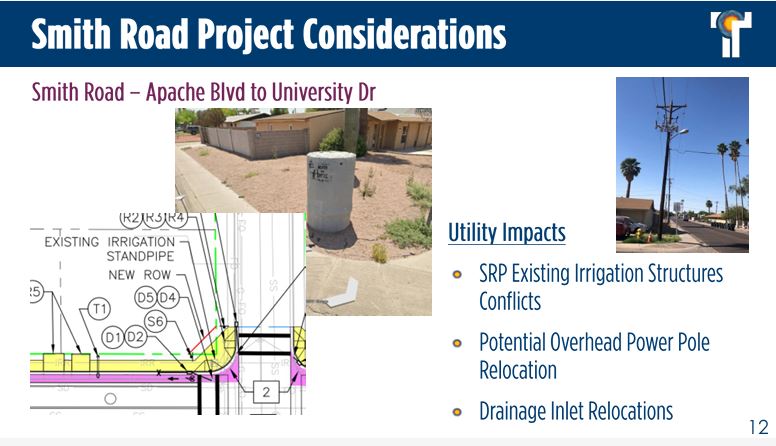
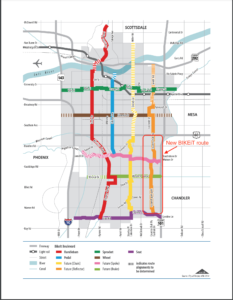
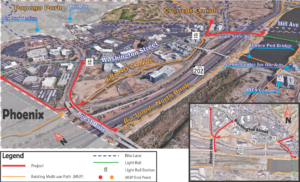

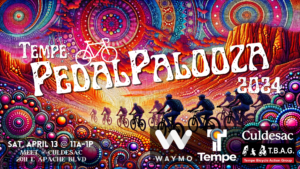
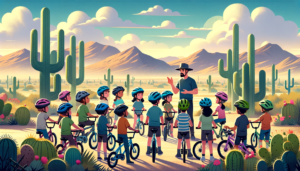
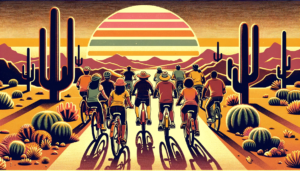
First, of course: drink lots and lots and lots and lots and lots of water. Before, during, and after. If you’re thirsty, you’re not drinking enough and it may already be too late to avoid heat exhaustion.
Second, learn to recognize your own body’s signs of heat exhaustion. They’ll be very similar to your signs of fever, and will include goose bumps, chills, and that sort of thing. Paradoxically and most unfortunately, one of the signs may be not wanting to drink. The initial signs will be very subtle, so it’s especially important to know and pay attention.
Last, at the first signs of heat exhaustion: back off! Greatly relax your pace at the very least and start sucking down the water like there’s no tomorrow, even (especially!) if the thought of drinking turns your off. If you’re healthy and in good shape, ten to twenty minutes at a walking pace while drinking lots of water should be enough to recover enough to get you back to a relaxed pace that’ll let you finish the ride. But if it doesn’t get better, IMMEDIATELY find air conditioning, or at least shade. And be prepared to call 911.
Heat stroke can come on VERY fast, and it’s potentially fatal. If you think you’ll be able to tough it out for the next five miles until the rendezvous point, don’t be surprised when you wind up in the ambulance or the coroner’s van instead. There aren’t any macho points to be gained here; this has much more to do with things like surface area to mass ratios and the like. No point in killing yourself over physics.
Cheers,
b&
sunscreen. visors. flexible work hours. ride slower. take the bus.
thats what i do!
I sometimes wet my shirts with very cold water and wrap a wet bandanna around my neck. This is probably more psychological than anything, but it tends to help me stay cooler.
I’ve found it incredibly important to plan out summer trips carefully. The extra preparation makes things less dangerous, although there’s no real way of completely avoiding the discomfort of hot weather on a bicycle.
In the middle of a summer day, the absolute maximum time that I can tolerate being outside on my bicycle is one hour, and I’m pretty sure that for most people, 30 minutes or under would be best. That means that if I’m planning on going somewhere, I need to know that I can get there in under an hour, and I also need to plan on staying in a cool spot for at least 45 minutes to an hour before setting out again (usually I’ll refill water at that destination as well). That’s on top of all advice on drinking lots of water/etc.
One other thing: figuring out which routes have more shade coverage can make a huge difference. Routes which have a lot of flood irrigation, like the Indian Bend Wash, also tend to be cooler, and that slight temperature difference make a big difference across long distances. There aren’t a lot of routes that have shade, but I’m always grateful for the ones that do!
Lots of good tips so far. I find keeping moving to help the most in mid-summer so I stick to arterials where there are far fewer stops/lights and if stopped the wait is much shorter. Waiting 2-3mi while on a secondary street to cross a major road is where I start to overheat on my 3pm commutes home.
Also important is acclimatizing. Most here already cycle nearly every day so it is not an issue, but if someone want to start cycling after May and has not already been active regularly outdoors will have to take is very slowly and avoid the hottest parts of the day, which could limit jumping into commuting.
If you do get a flat/mechanical seek an indoors place to repair or at least some shade. Again you are stopped and no longer have the cooling breeze.
In addition to the pee color test, if you have a scale weigh yourself every morning after elimination and every afternoon/evening just after cycling – not to check if you like your weight, but to check if there are significant differences which can be from dehydration.
Al
Yea all good tips above some ones I didn’t see.
I sometimes wear a wet t-shirt during the dry months.
I also locate all the public pools along my route. (in Phoenix I can buy a 20 dollar season pass)
I look for big box stores or malls (AC/shade ) if my route is more than an hour. As mentioned above.
I try to drink my water a day ahead of time. (like AL said with weight)
Clothes Wic shirts, and lycra.
I locate places I can take showers not only to cool off but remove some sweat.
I have my emergency bus money and the times the bus will come along the route.
Buy Icecream
Ride at night
Know how to take your pulse (and be familar what rates their are) as this is a good sign of you overheating.
Read important health information (symptoms)
my favorite summer tip is freezing water bottles some solid all the way to the top, some half way up for shorter trips, topped off with some chilled sports drink, also if I use a hydration pack I pack it with peices of ice, as full as I can and again sports drink makes a difference when you sweat a lot.
Loose, light colored, long sleeve cotton shirt and even pants/knickers. Cover up! Loose means air gets pumped in and out. Aerodynamics suffer, but you will not suffer so much. Expensive solar clothing is available, but in our climate, used cotton is a high performance fabric, IMHO. Seersucker cloth, believe it or not, see http://www.rivbike.com, and the Goodwill, of course. Wet rag/ice in the helmet for a treat.
As for water, yes, but you may find a need for the electrolytes, too, since on a bike you are always in the wind and drying out releases salt, as your gloves and other clothing will attest, becoming stiff with the stuff. Experience counts here. Too much and too little of either water or electrolyte is very bad. Don’t just rely on “sports drinks”; try fruit and vegetable juices, too (V-8 from a convenience store? Bananas, anyone, in the hot sun? Ice pack in the saddle/handlebar bag…) So, the old advice of Velocio holds: drink before thirsty, and seek the moderate levels of effort your human motor can produce in extreme heat.
http://cycling.ahands.org/bicycling/velocio.html
Our bodies have to heat up to digest ice cold water (and vice versa), so drink room temperature water. Your urine should be a translucent pale yellow, if not, your body might need some more H20.
Chapstick! SPFs, even the strong ones, need to be reapplied every hour or two.
Morning Rides in the desert, away from all the asphalt, you can avoid some of the heat.
Also, agreeing with Ben, as I learned my first summer in AZ, heat stroke is very serious.
I wet a sock and put my bottle inside it to help keep my water cooler longer, evaporation theory. This works great. When I get home I jump in the pool.
I also wear a wet bandana around the neck and reapply when it gets dry. Ice in the water helps too. But too cold might limit your ability to breath easy, so be careful with real cold water.
I concur with what Emily said. However ice water for some (not me) is more enjoyable. Far more important than the water temperature is the quantity.
Same for the wet-shirt. Even when it is 115F outside I find starting with a wet shirt to make me feel chilly where the wet touches my body. Evap cooling at its best with 5% RH and a 15mph wind!
However in the long run I find the cold shirt only delays my body’s appropriate response to heat so when the water evaporates away (which can be in the first 5min of a 40min trip) then I feel hotter than if I had just started with a dry shirt and let my body provide the sweat from the get go. Instead with a wet shirt I suspect with those cold patches on my skin by body is starting out in warming mode (reducing heat loss from skin by constricting surface blood vessels) then it has to switch gears mid-ride to cooling, a delayed response.
Al
Just wanted to let Kate know that the ‘cycling in heat’ summary sheet (with the cycling resources on the back) was great to see at the BtW stop this morning.
The summary did a great job of pulling together all the (varied and occasionally conflicting) advice above into one page of clear and straightforward advice for all.
Al
Actually, big thanks to Rebecca for pulling the cycling in the heat tips sheet together at the last minute, since I’m in Boston this weekend at a conference. Sounds like the event went well! Thanks to all who helped out!